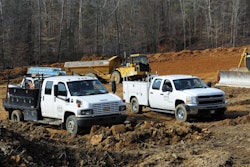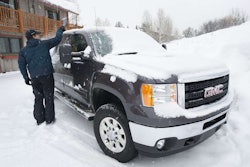SHOP TALK: Tips to keep your pickups in tip-top shape
By Steve Temple
Additives for Ultra-Low Sulfur Diesel?
 Stanadyne’s lubricant with cetane (don’t use with
Stanadyne’s lubricant with cetane (don’t use with
Ford’s cetane booster)
 BG’s DFC Lubricant
BG’s DFC Lubricant
Back when gasoline formulations changed from leaded to unleaded, the lack of lubrication for the valvetrain became a concern.
For diesel owners, a similar concern arose during the change to ultra-low sulfur diesel (since the sulfur content lowered from 500 ppm to about 50 ppm).
We attended a seminar sponsored by Shell Rotella a few years back and asked about this point, and the tech guys claimed that lubricants have been added to compensate for the reduction in sulfur, but declined to reveal any specifics.
Other petroleum experts we contacted indicate that while sulfur used to be the primary lubricant in diesel fuel, new ones are formulated from ester, amide or polymer products, from both organic and synthetic sources.
 Ford’s cetane booster works on all makes of diesels to improve burn and mpg
Ford’s cetane booster works on all makes of diesels to improve burn and mpg
They point out, however, that if the fuel blender doesn’t properly add them, over time you might encounter some problems. As a general rule of thumb, it’s just common sense to buy fuel at busier stations, where it doesn’t have time to get stale.
As for aftermarket fuel additives, we’ve tried a number of them, ranging from injector cleaners to cetane enhancers.
A couple of different mechanics and fellow diesel enthusiasts specifically recommended the Ford cetane improver, which can be used in any brand of diesel engine.
Others like to use Stanadyne’s lubricant, but since its formula includes both cetane and lubricity additives, it shouldn’t be used in conjunction with another cetane additive.
When used alone, it not only improves mpg by providing more complete combustion, but also can loosen up sticky injectors on Duramax engines in particular.
We’ve also seen mileage improvements with Lucas lubricants, and independent testing by Advanced Refining Concepts (a fuel refiner that makes GDiesel) indicates that BG’s DFC (Diesel Fuel Conditioner) works well in removing and preventing deposits.
A couple of low-dollar alternatives are to spike your fuel with either a bit of biodiesel (as little as two percent helps, which is what Scheid has put in its race-truck tanks) or some two-stroke oil at a 200:1 ratio (but not regular motor oil).
ATF is not recommended, as it doesn’t lubricate as well and can leave deposits.
Cummins Fuel Injectors
In a previous Shop Talk column, we reported some fuel-injector issues, courtesy of Collins Diesel Injector. Cheyne Beukes of BD Diesel threw in a couple more comments along those lines.
 Ford injectors
Ford injectors
“We see a lot of injector-related problems come through our service center, especially with the common-rail on Dodges, usually at 150,000 kilometers.
If it’s hard-starting, you need to use the correct scan tool to monitor the fuel pressure,” he notes. “If it’s not right, you’re almost guaranteed that you have a high-return flow (high pressure leak).”
Unfortunately, identifying which injector is failing with a cap test can be labor intensive and expensive, so in some cases it might be cheaper to replace all six of them instead (but not in all situations).
Beukes recommends using Bosch remanufactured injectors (or BD Diesel’s brand), but added that before doing so to check the lift pump, tank and fuel control actuator to eliminate all the other possible causes of a hard-starting condition on a Dodge common-rail fuel system.
Cleaning MAF Sensors
Oil-impregnated aftermarket air filters are one of the most popular upgrades on the market, but be warned: BD Diesel’s service manager Cheyne Beukes says the MAF sensor on the Chevy Duramax is sensitive to both moisture and over-oiling.
So when cleaning the aftermarket filter element, make sure it’s thoroughly dry before oiling. (Though, oddly enough, he notes that an older 12V Cummins runs better with a bit of water in the intake).
Beukes also points out that over-oiling the filter can contaminate the MAF sensor’s wire element, causing the engine to throw a code and even go into limp mode.
Spraying the MAF sensor inlet with an aerosol cleaner for electrical contacts might correct this problem.
Also be sure the MAF sensor in the aftermarket cold-air intake is installed correctly; the sensor opening should point toward the air filter end of the intake tube.
Engine Cooling Tips
If your work truck does duty in a hot climate, we’ve got a few tips to keep in mind for your cooling system for all three major brands.
 EGR valve with carbon buildup
EGR valve with carbon buildup
 Heat exchanger to cool oil can get clogged by casting sand; use coolant filter to keep out sludge
Heat exchanger to cool oil can get clogged by casting sand; use coolant filter to keep out sludge
Starting with Chevy, the LLY Duramax diesel has a reputation for overheating, partly because it has a smaller fan than the one on the earlier LB7 model (19 versus 21 inches).
The ‘06 LBZ in particular has a 23-inch fan plus a larger radiator. The good news is this cooling system can be fitted on an LLY.
However, before going to that much trouble, check the air filter; a clogged element can raise engine temp, as can a plugged-up catalytic converter.
To check for the latter, drill test ports both before and after the cat, and then compare the pressure readings on each.
 2008 Ford Super Duty’s radiator with plastic components to support aluminum core; subject to failure
2008 Ford Super Duty’s radiator with plastic components to support aluminum core; subject to failure
Another possible cause of overheating is from the engine electronics, which can learn to flow too much through the EGR.
Or, on the LBZ Duramax, which has variable vanes, the turbo position controls might be restricting exhaust flow. The Check Engine Light might not come on in this scenario.
So, have your dealer re-calibrate the PCM (Powetrain Control Module).
Not sure which model Duramax you have? Look at the eighth digit on the VIN: A number “2” indicates LLY while the letter “D” designates LBZ.
Reports of leaky radiators are common on the 2008 Ford Super Duty, and the plastic components supporting the aluminum core can also be a problem.
If you find that’s the case, consider replacing the water pump at the same time to save money on future replacement, which we hear might be needed as often as every 60,000 miles.
Clogged EGR valves are also an issue on Power Strokes, possibly due to either carbon buildup – or sand from the block casting getting into the coolant. We plan to focus on a preventive course of action in an upcoming tech article showing how to install a coolant filter.
If you need a quick fix for overheating, we’ve had some success lowering engine temps on a Cummins diesel (and other brands) with Lucas Super Coolant.
We noticed an immediate drop in running temperature of about 15 degrees in the hot desert after pouring a bottle in the radiator. The company claims as much as a 20-degree difference. We didn’t see that much of a change, perhaps because we able to flush the radiator as recommended.









